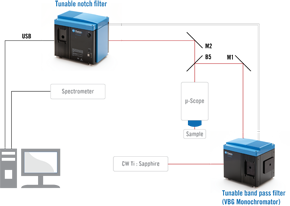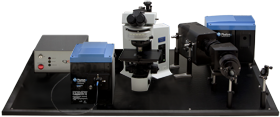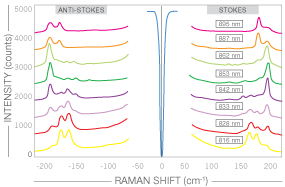Photon etc. has designed two narrowband tunable filters for resonance Raman spectroscopy. These matched tunable passband and notch filters, based on thick volume Bragg gratings, exhibit a bandwidth less than 10cm-1 and cover a wavelength range of several hundreds of nanometers.
Raman spectroscopy (RS) is a powerful tool to study vibrational, optical, and electronic properties of materials in a nondestructive manner. Raman signals are typically orders of magnitude lower than the intensity of the excitation laser line. However, it is possible to significantly increase Raman signals by choosing an excitation wavelength that corresponds to an optical transition of the material under investigation.
Resonant Raman Spectroscopy (RRS) provides a unique tool to characterize the diameter and chirality distribution of a mixed population of carbon nanotubes (CNT). RRS is also a powerful method to monitor in-situ the CNT properties during growth. Thus, it can serve as a diagnosis tool in order to achieve better control of the CNT production.
Experimental Conditions
Using volume Bragg grating (VBG) technology, Photon etc. has developed, specifically for RRS, two types of ultra narrow band tunable filters: a laser line filter and a notch filter.The Laser Line Tunable Filter (LLTF) is installed just after the Tunable Ti:Saph laser (Figure 2) and blocks the unwanted fluorescence produced by the laser, leaving the excitation laser line untouched. Two steering mirrors (M1 and BS) send the laser line into a standard microscope where the laser beam is focused on the sample of interest. The second filter, a Tunable Top Notch Filter (TTNF), is installed after the microscope. The TTNF blocks the Rayleigh scattering coming from the material, leaving the Raman signal untouched down to 50 cm-1 with a throughput up to 80%. The tunable filters are controlled by a computer via USB links, allowing fast wavelength selection.
Results
Stokes and anti-Stokes Raman spectra of single-walled carbon nanotube (SWNT) powder (Figure 1) were measured within less than 1 h using a standard spectrometer. Each peak corresponds to a radial breathing mode (RBM), and the center frequency of a given peak is inversely proportional to the nanotube diameter of a given population. Several populations of nanotubes with different diameters can therefore be readily observed and effectively characterized.
F.1. Raman spectra of carbon nanotubes using
TI:SAPH Laser & Tunable Top Notch Filter
(Courtesy of Prof. R. Martel, U of Montreal)
F.2. Resonant Raman System Configuration




